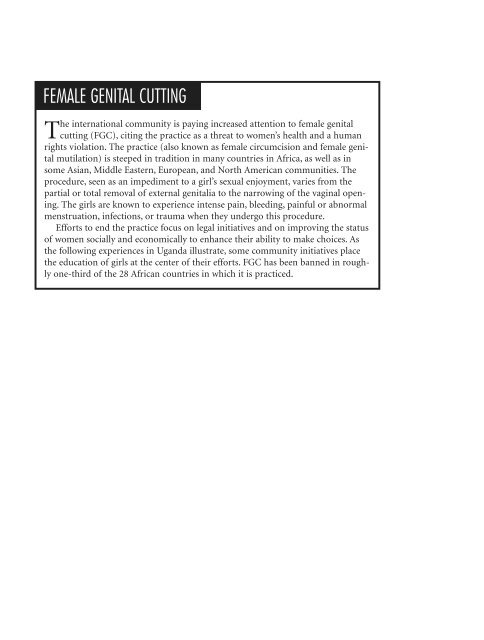Report on ender- ased Report on ender- ased
Report on ender- ased Report on ender- ased
Report on ender- ased Report on ender- ased
Create successful ePaper yourself
Turn your PDF publications into a flip-book with our unique Google optimized e-Paper software.
FEMALE GENITAL CUTTING<br />
The internati<strong>on</strong>al community is paying incre<strong>ased</strong> attenti<strong>on</strong> to female genital<br />
cutting (FGC), citing the practice as a threat to women’s health and a human<br />
rights violati<strong>on</strong>. The practice (also known as female circumcisi<strong>on</strong> and female genital<br />
mutilati<strong>on</strong>) is steeped in traditi<strong>on</strong> in many countries in Africa, as well as in<br />
some Asian, Middle Eastern, European, and North American communities. The<br />
procedure, seen as an impediment to a girl’s sexual enjoyment, varies from the<br />
partial or total removal of external genitalia to the narrowing of the vaginal opening.<br />
The girls are known to experience intense pain, bleeding, painful or abnormal<br />
menstruati<strong>on</strong>, infecti<strong>on</strong>s, or trauma when they undergo this procedure.<br />
Efforts to end the practice focus <strong>on</strong> legal initiatives and <strong>on</strong> improving the status<br />
of women socially and ec<strong>on</strong>omically to enhance their ability to make choices. As<br />
the following experiences in Uganda illustrate, some community initiatives place<br />
the educati<strong>on</strong> of girls at the center of their efforts. FGC has been banned in roughly<br />
<strong>on</strong>e-third of the 28 African countries in which it is practiced.

















